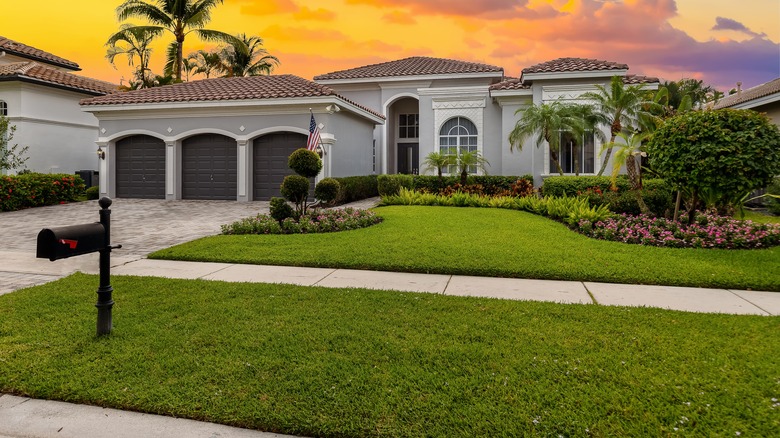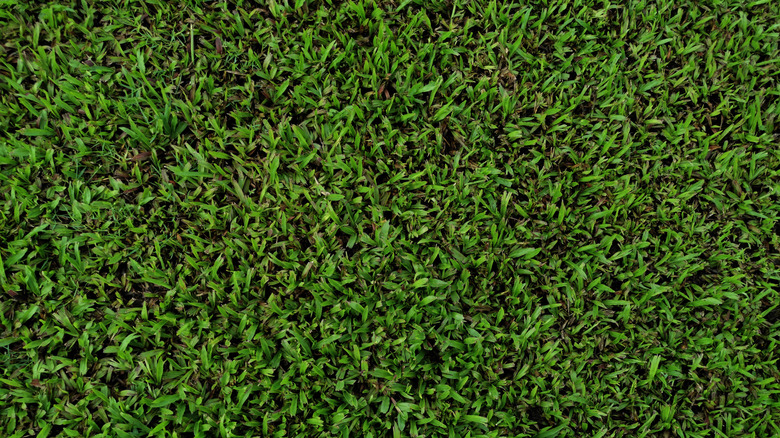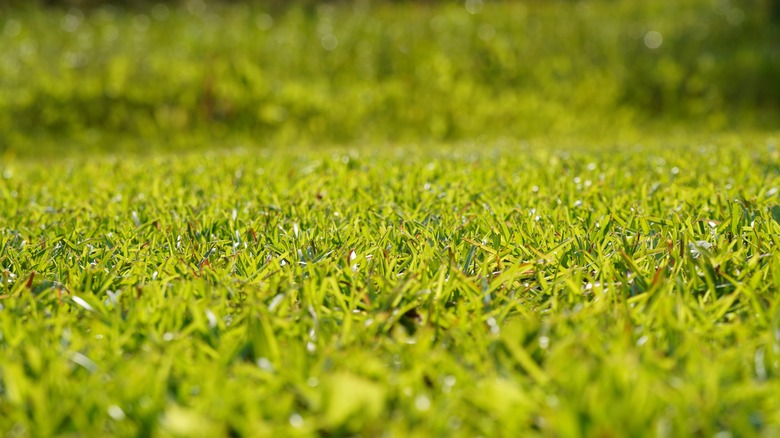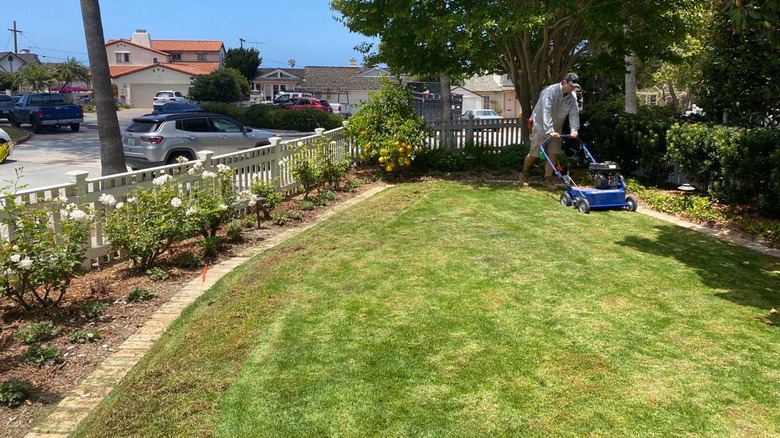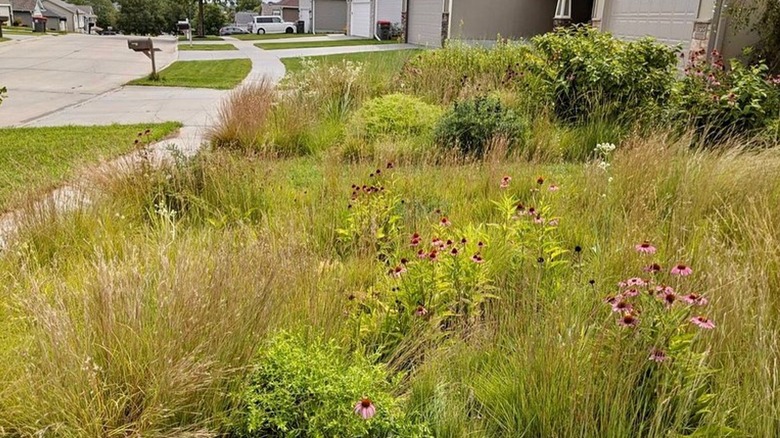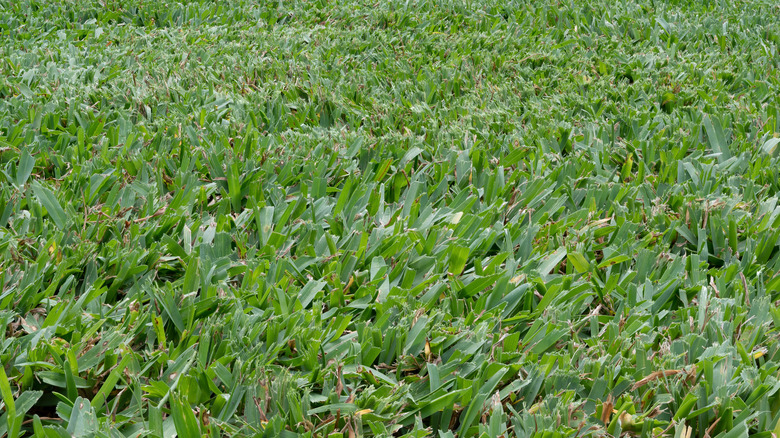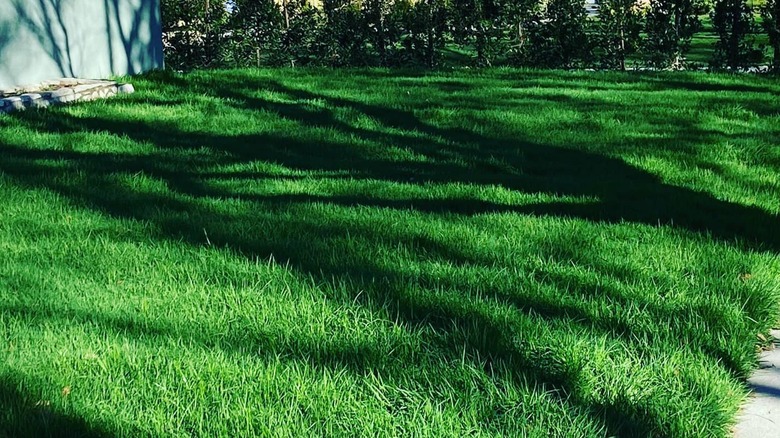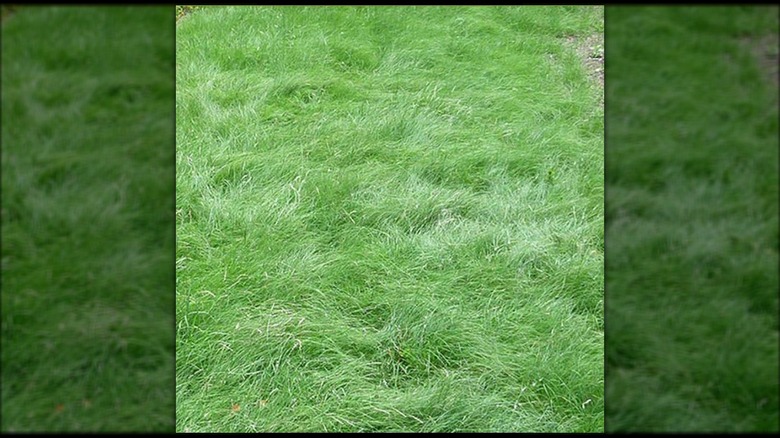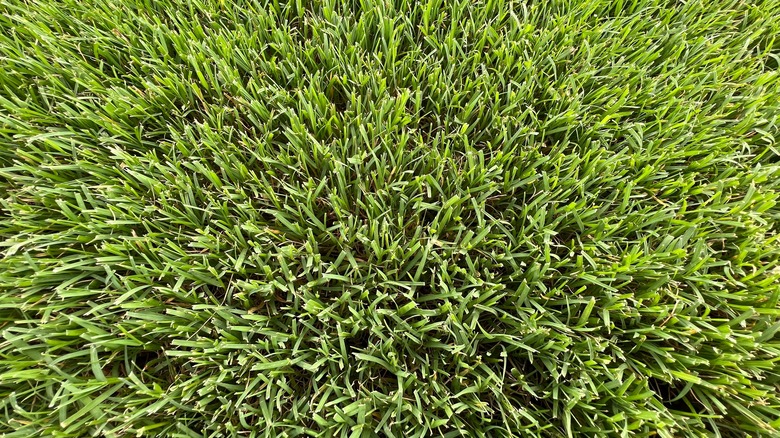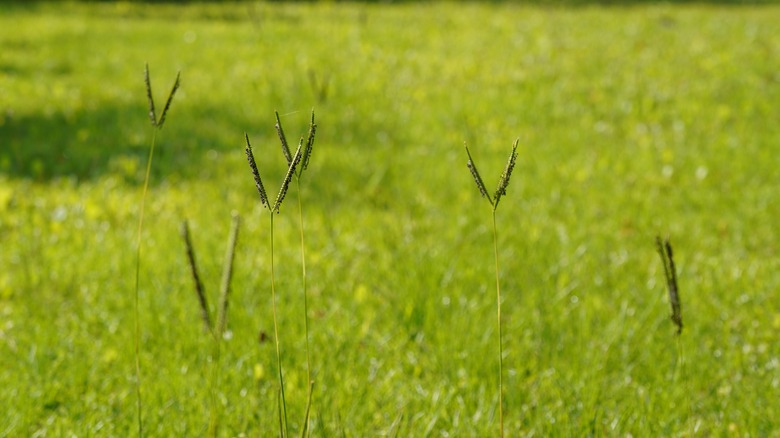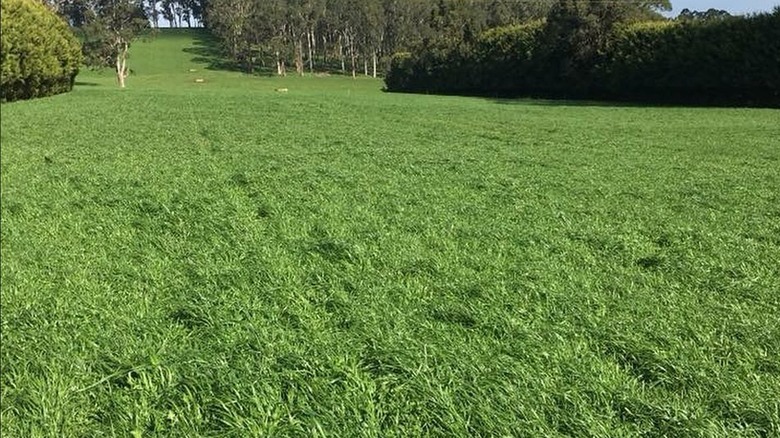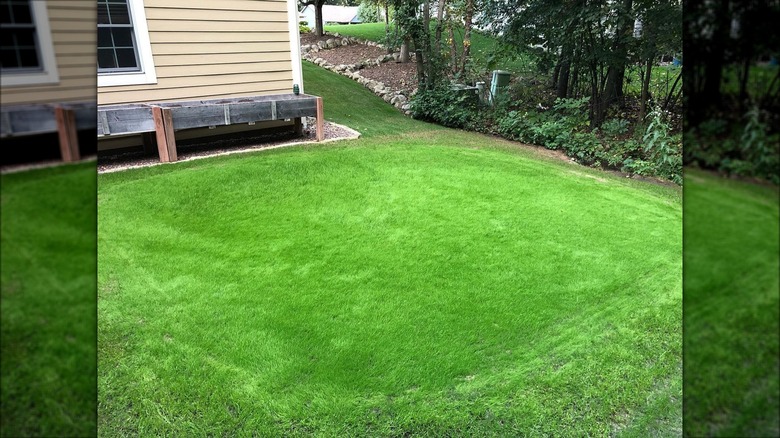7 Grasses You Should Plant For A Lush, Green Lawn & 4 That Should Be Avoided
Popular campaigns like "No Mow May," "Water-Efficient Landscaping," "Grow Food, Not Lawns," and "Anti-Lawn Movement" have underscored all things wrong with the meticulously clipped verdant expanses ruling our yards. Lawns play poor hosts to birds and pollinators, are elephantine water guzzlers, and best only concrete to earn the neighbor's begrudging envy. Yet, they're prized, not just for their aesthetics but for their functionality. From familiarizing toddlers with nature, watching dogs chase balls, and walking barefoot to recreating Tissot's painting of indolent family time a la "In Full Sunlight" style for reels, lawns have served as laudable backdrops. So, unless homeowners are given worthy substitutes that achieve this and more, well-meaning change will be glacial, if at all. However, the status quo can be changed if we lend our ears to another catchphrase: "Go Native."
Like their introduced counterparts, native grasses can be mowed to create the picturesque, groomed look that has fueled the popularity of lawns without being as resource-intensive. Plus, if you're a slacker or happen to live in a city conscious about reducing lawn acreage, you can let the turf grow wild, throw in a few wildflowers, and watch birds flock in for nesting or snacks. That being said, it's important to note that no grass is perfect, and factors like the site's conditions, expected foot traffic, appearance requirements, and the climate should inform your choice. With that said, let's look at some native grasses and learn about the ones you can do without.
Plant: Common carpetgrass tolerates poor, compacted soils
Endemic in the warmer US regions (central to south-east), common carpetgrass (Axonopus fissifolius) grows 6-inch long, slender green blades that some might mistake for St. Augustinegrass or centipedegrass. However, when summer coalesces into fall, their leaves assume a reddish tint, unlike the strawy texture common for other warm-season, perennial grasses. Additionally, they feature 1- to 4-inch long seedheads that may appear uncannily similar to crabgrass. However, the matter remains: why should you consider using shade-tolerant carpetgrass in your yard? For starters, it thrives where most other grasses don't and outcompetes weeds, too. If your site has one or more of the following conditions: poor fertility levels, compacted soils, high heat and humidity, or poor drainage (wet soils), carpetgrass is your comrade. Moreover, since it grows no taller than 20 inches even when unmowed, it makes excellent recreational space while enabling you to peek at trilling songbirds.
Carpetgrass is cold hardy in zones 7 to 10, provided the day temperatures don't move beyond the 60 to 90 degrees Fahrenheit range. In fact, it retains its medium green hue throughout the Floridian summer, growing dormant by fall elsewhere, although some gardeners favor blending it with centipedegrass for greater visual impact. While the native's dense mat is no cushy blanket like bermudagrass, it tolerates shade better. Seed it in full sun in slightly acidic soils, and watch the lawn establish in under 10 weeks. Remember, though, carpetgrass doesn't take well to salt and trampling.
Plant: St. Augustinegrass has good shade tolerance
A go-to for sub-tropical American dwellers, especially in and around Texas and Florida, St. Augustinegrass (Stenotaphrum secundatum) is popular due to its looks and utility. Its dense, bluish-green mat invites appreciation from plenty, with small mammals and birds being no exceptions. They lust after its blades, inflorescence, and seeds. Besides, as turfgrass, it doesn't demand consistent pruning to maintain its looks, although if you insist, it will appreciate the cut. Tracing its origins to the southeastern US, St. Augustinegrass has found its takers amongst gardeners limited by shade. The native grass can be grown as an understory for tall trees or be sodded in shaded areas, albeit the best green-up occurs in full sun. Since the turf roots deeply, it exhibits greater drought resistance vis-à-vis its warm-season counterparts. Salt-rich, desert planting mediums are no bar.
While St. Augustinegrass isn't particularly cold-hardy, it endures well in zones 7 to 12, with its gorgeous green hues remaining well past the fall frost. It flourishes in most soils, albeit it requires maintenance. For instance, sandy soils require monthly fertilization. Also, it can only be established vegetatively with sod, sprigs, or plugs, with the latter taking a full growth season to cover the ground, but weeds will be a non-issue afterward. Unfortunately, these perennial grasses are prone to attacks from chinch bugs, a destructive pest notorious for killing your lawn. So, look for cultivars with better tolerance, like Captiva. Some may find their wear tolerance sub-optimal.
Plant: Seashore paspalum is ideal for saline soils
If you assumed the brackish areas of your yard could only be paved with concrete, seashore paspalum (Panicum vaginatum) would love an appointment. Found along the coasts of Texas, Florida, and other southern areas, this native grass is ideal for saline soils, which also explains its alternative names like Seaside Millet, Saltwater Couch, Salt Jointgrass, and Siltgrass. It doesn't even mind seawater irrigation. When regularly mowed to under twelve inches tall, it produces a thick carpet of gorgeous blue-green grass blades, or a striped effect, if it's a two-toned cultivar, reducing all wiggle room for crabgrasses. Conversely, if left untouched, the grass can grow up to 30 inches tall, with the stems terminating in hairy, forked foliage.
Seashore paspalum offers excellent footing, meaning you're unlikely to slip on wet grass. Nor is it susceptible to uprooting — a fact cemented further by its soaring popularity as sports turf — which is good news since it can't be overseeded. Although some venture seashore paspalum has a similar mien to bermudagrass, it doesn't require as much nitrogen. Also, it thrives in most soils, including nutrient-poor, sandy, and metal-contaminated provided the pH ranges between 6 and 8. Shade, frost, and disease resistance (think fusarium blight) aren't its forte. Since its seeds are unviable, it's best to sod the warm-season grass, but if budget is an issue, sprigs can be used to establish a full lawn in under two weeks. However, it's considered invasive in California.
Plant: Side-oats grama grass enjoys rocky, infertile sites
Those from Texas may already be familiar with their state grass, side-oats grama (Bouteloua curtipendula) — crowned so for its nutritional value to foraging animals and critical role in the 1930s grassland restoration. But what you might not be aware of is this native grass can double as turfgrass. All you need to do is cut its greyish-green, hairy foliage to 2 to 4 inches, rather than letting it mature to its typical 3-foot height, lending your lawn the lush green monoculture look. Of course, this means you'll have to let go of its ornamental value, especially when its leaves turn purple in the fall.
Barring the southeastern region, side-oats grama is usually found along the area between the Rocky Mountains and the eastern coast, especially in the Great Plains. It has a penchant for finely textured, alkaline soils and displays decent salt tolerance, but is accepting of infertile, compacted clay, and dry substrates. It's particularly recommended in xeric landscapes (or to water-wise landscapers), given its lower irrigation, fertilization, and other maintenance requirements and, yet, successful elimination of pesky weeds. It's better than cool-season grasses because it greens up in peak summers (given it is sun-loving) when they've gone to sleep. Side-oats grama can tolerate some shade if necessary. Even though its grass seeds germinate within a week, its clumps take time to spread enough to cover the soil.
Plant: Buffalograss offers a unique, low-maintenance aesthetic
Often touted as a replacement for Bermudagrass, Buffalograss (Buchloë dactyloides) has one-upped its cousins by laying out a dense, green sod earlier than they can manage in spring. It usually features over 3-inch long, wavy, gray-green leaves that add up to make a 3- to 6-foot-tall plant, spreading ⅓ as wide when not given a trim. Plus, they may (infrequently) flower from spring to fall, enticing birds and butterflies to your yard. However, the reason buffalograsses are widely fêted has little to do with their nativity — although being a prairie grass has its perks. Instead, it's about what they bring to the table. These stoloniferous spreaders vastly reduce mowing requirements to about once every two weeks, survive on a single (rarely two) feeding, and can remain lush at half the irrigation necessary to keep Kentucky bluegrasses alive — truly epitomizing how low-maintenance turfgrass should be. Additionally, they're unbothered by disease and drought.
However, there are downsides to a buffalo grass lawn. Its fine texture allows weeds or competing cool-season grasses to encroach into the yard until establishment. Also, it wakes up late from winter dormancy, extending the time the lawn remains unsightly. At elevations exceeding 6,500 feet, it can suffer winter damage, though varieties like Turffalo, Legacy, and Prestige perform better. Buffalograss is well-adapted to dry prairie regions (under 30 inches of rainfall) and should preferably be sodded or plugged in lawns expecting moderate movement.
Plant: Native Bentgrass provides massive water savings
Native or leafy bentgrass (Agrostis pallens) is a cool-season variety, indigenous to California, but also found in some parts of Utah and Montana. The perennial grass develops up to 4 inches long, slightly grainy, deep green blades that grow rolled as they mature. When left to its own devices, the pet-friendly greensward mimics a wild meadow with the plant standing between 24 and 32 inches tall. However, it can be conveniently mowed down to a height of 1½ to 2 inches for a manicured turf appearance. The main highlight of native bentgrasses is that they aren't thirsty, implying growers can reduce their irrigation bills by almost 50% without losing a shred of verdancy. Plus, some selections are highly durable, capable of withstanding and repairing immense damage.
Sadly, as native bentgrasses have a slow-growing habit, they can't be seeded. Instead, they're best grown as sods, which raises the expense significantly but provides a ready lawn in under two weeks. It's best to plant bentgrass in full sun for the best look, although it won't take umbrage to partial shade.
Plant: Blue Grama's drought tolerance is top-notch
Another native worth consideration is Blue Grama (Bouteloua gracilis), a low-maintenance grass option that's also drought-resistant. Generally used to restore abandoned sites or pastures, or as accents in ornamental beds for their gorgeous, purple flowers that line the stalks like eyelashes — hence earning the moniker eyelash plant — they can be suitably trimmed to establish green turf. The key is to mow the otherwise 12- to 14-inch tall plant down to a height of 2 inches to knit together its graceful, grayish-green clumps into a lawn. However, the ¼-inch wide leaves may turn a striking copper or blonde with burgundy or orange edges around fall, which may not suit everyone's taste.
While the warm-season grass tolerates black walnut, urban pollution, and sub-par fertility, drought resistance is where it shines, and that's saying something when competing against the likes of buffalograss. It survives even in desert climates on as little as 7 inches of rainfall, albeit the clumps won't inter-mingle, prompting some gardeners to mix in buffalograss to achieve a unified look. That being said, blue grama favors dry soils, provided they drain well, and thrive when watered monthly. Winter hardy in zones 3 to 10, it forms sod at elevated heights. Keep the self-seeding grass tall, as the shaded roots will need less water during drought. Sow its seeds in alkaline soils in sunny sites at little risk of flooding, or the grass will rot.
Avoid: Bermudagrass is unfit for cool climates
Acknowledged as the South's "sports turf," bermudagrass (Cynodon dactylon) has seen hay days ever since its mistaken introduction (followed by deliberate planting) into the United States in the 1700s. Poor soils, hot climates, droughts, and high salt content — bermudagrass weathers them all, maintaining its characteristic classy green. Yet, this very resistance makes it a nuisance in areas around the Mason-Dixon line. Thanks to its numerous seeds, stolons, and rhizomes, it's a ubiquitous weed that refuses to leave even when told to, earning the moniker of "wiregrass."
But why is it unwanted, you ask? Because, the shade-intolerant variety assumes a tawny, lifeless appearance at the onset of winter, in sharp contrast to the lively greens of tall fescues and Kentucky bluegrass. Additionally, the dormant, bare patches are susceptible to erosion. But its worst offense is that it's nigh impossible to get rid of bermudagrass unless you let your overseeded lawn run wild — 4-foot-high tall fescue can outcompete the weed — or use an herbicide like Roundup. No wonder, the "noxious weeds" and "invasive" lists of several councils, including Maryland, Utah, West Virginia, Georgia, and California, are replete with mentions of this warm-season grass. Further, as it produces copious amounts of pollen, it has been banned in Clark County for being an allergen. Bermudagrass doesn't exactly scream low maintenance when it keeps its growers busy with countless pests and disease infestations.
Avoid: Bahiagrass is high maintenance
Homing with bermudagrass, bahiagrass (Paspalum notatum Fluegge) is another affordable, drought-resistant grass that gardeners know about and plant willingly, as it isn't as big of a disease magnet. However, this doesn't denote that pesky insects leave it be. On the contrary, mole crickets, billbugs, and armyworms are quick to rule the roost, causing everlasting problems. However, the cake goes to the grass itself. Imported as a forage substitute in 1913, bahiagrass has become a scourge in most pastures and turfs, given its aggressive behavior and tendency to outcompete anything falling in its path. The warm-season perennial's impenetrable, bright green mat — the reason it's charming for homeowners — is tough enough to deny the right of way to hardy pines if someone takes it upon themselves to restore a site. Worse, it's even harder to eliminate its tufts once rooted without going the herbicide route. That's why Georgia and South Carolina have ruled out bahiagrass as an exotic pest.
Another downside is that bahiagrass is neither easy to seed (given the poor germination probabilities and the resultant commercial unavailability) nor easy to maintain. Intact, the 1-foot-high foliage gets topped with Y-forked, 2-foot-long inflorescence and seedheads that make cutting the grasses back onerous later down the line. That's assuming growers find their open canopies attractive at all. Thus, they're best left for highways and roadside ditches where visual interest isn't foremost.
Avoid: Annual ryegrass has a short lifespan
If you've ever bought white-labeled commercial seed mixes off the shelf in your hoard to quickly turn your barren yard into a booming green oasis, odds are you've introduced annual ryegrass (Lolium multiflorum) to the area during the process. Even though the bunching, cool-season grass spreads in less than a week, the concern is that it won't survive long enough for the permanent grasses to mat out. After all, there's a reason they're called annual. This complicates things, as exposed spots are vulnerable to erosion and weeds.
Although reseeding is a possibility, the costs add up. Not to mention the additional maintenance costs as the prolific spreader necessitates frequent mowing (sometimes over twice a week) to keep it neat and in check. Above all, the European import can turn weedy if grown with other cool-season grasses, especially tall fescue. It has already lost favor with the plant councils of California and the City of Ann Arbor.
Another instance where annual ryegrasses are a concern is when they're used to overseed warm-season lawns for winter interest, which is surprising as such practices haven't been endorsed for turf, with bermudagrass as the lone exception. This is because they die when the mercury hits 80 degrees Fahrenheit, leaving an unruly mess if the primary lawn grass takes longer to wake up. Their modest drought tolerance is another disadvantage.
Avoid: Creeping bentgrass entails expensive upkeep
Not to be confused with native bentgrass, creeping bentgrass (Agrostis stolonifera) has its roots in temperate Eurasia; although that hasn't curbed its use in sports fields and golf courses. Hardy to zones 3 to 6, creeping bentgrass, or carpet bentgrass as it's synonymously called, is prized for its soft texture, wear tolerance, and no limits to mowing height. Keep it under ½ inch if you like and watch it prosper and spread its stolons like there's no tomorrow. Naturally, such characteristics make the grass appealing to homeowners. However, planting the cool-season grass is an unwise decision, as it's as high maintenance as any turfgrass can get. To keep the turf green and healthy, you'll need to water and fertilize it frequently. Moreover, the grass attracts unwanted attention from scores of disease-causing organisms, mandating the use of expensive fungicides. Besides, when you maintain it short, it excretes buckets of thatch, which is a mess to clear out.
Another factor that homeowners fail to acknowledge is that its easy recuperation is a double-edged sword. Since the grass is quick to dense out, it can escape the boundaries if it finds favorable conditions in adjoining areas, including your flower beds or turfgrasses, turning weedy. The worst part is that employing cultural practices won't help banish the grass, as its presence is usually indicative of poor drainage. Several states, including California, Kentucky, and Maryland, have featured creeping bentgrass on their invasive lists.
